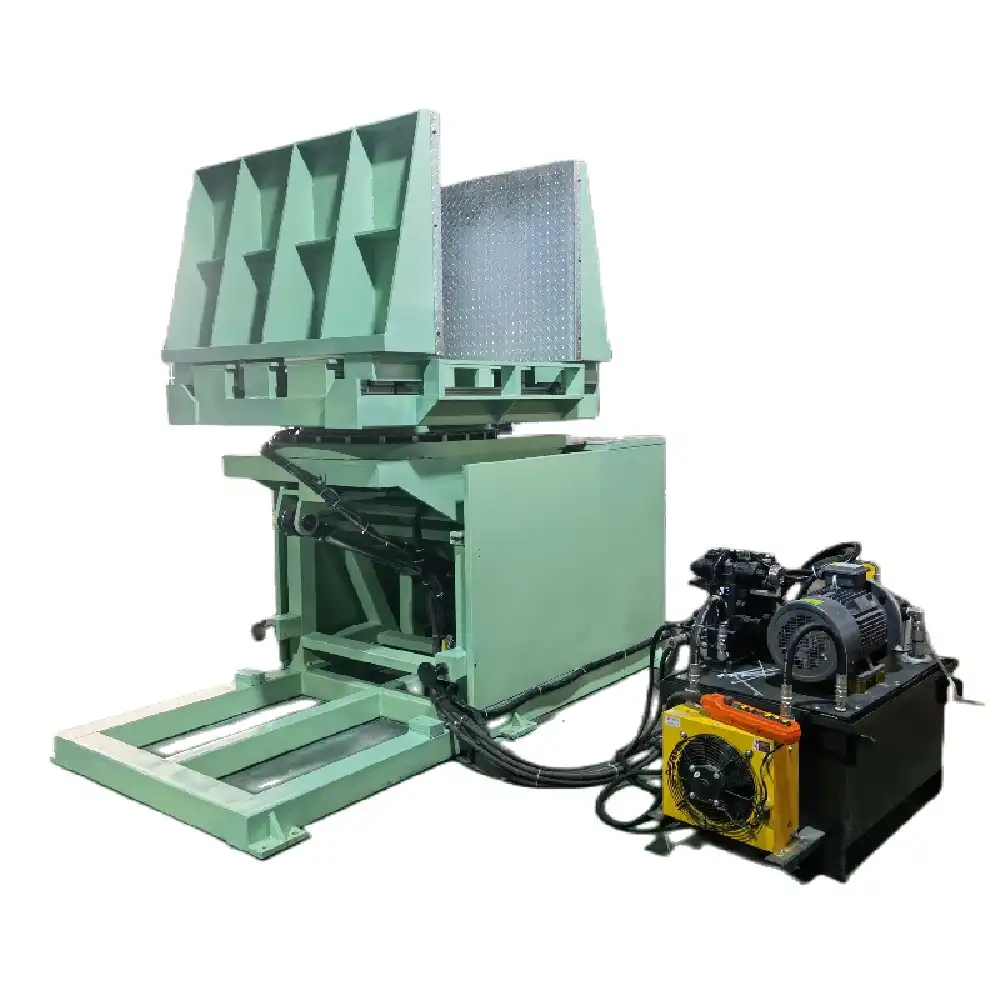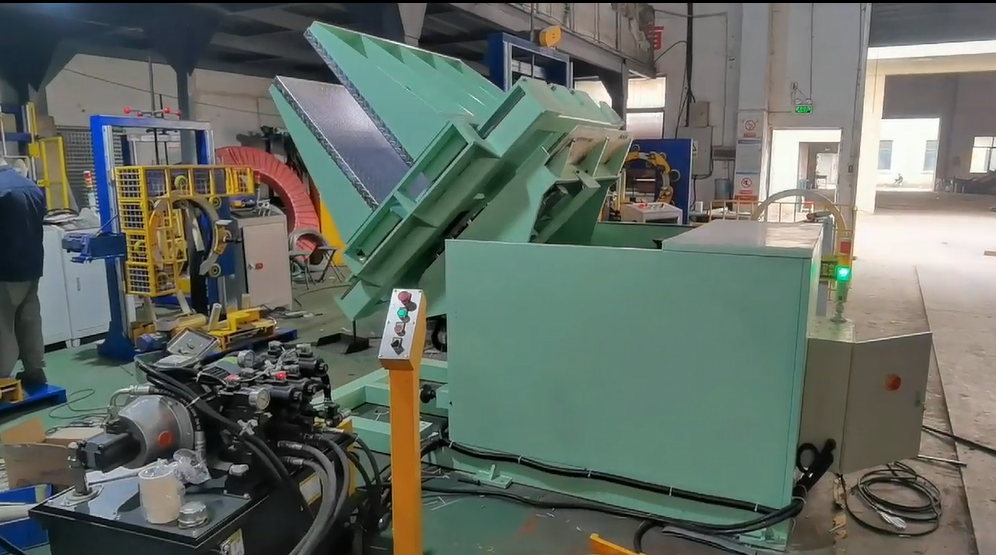The Reclining and Rotating Pallet Inverter represents a significant advancement in material handling technology, specifically engineered by manufacturers to streamline the process of exchanging or removing pallets from beneath heavy or unstable loads. This sophisticated equipment is indispensable in modern logistics, warehousing, and manufacturing environments where efficiency, safety, and load integrity are paramount. By enabling both tilting (reclining) and full 360-degree rotation, these machines offer unparalleled flexibility for pallet transfer, load squaring, and accessing damaged goods at the bottom of a stack.
1. Key Features and Design Specifications
This type of pallet inverter is constructed with durability and performance in mind, tailored for demanding industrial applications.
- Structural Integrity: The core structure typically features a heavy-duty, welded steel frame designed to withstand continuous operation under substantial load. High-grade steel ensures longevity and stability during the inversion cycle.
- Drive Mechanism: Precision movement is often achieved through a combination of robust hydraulic systems for clamping and tilting, providing smooth and controlled power, and electric drives for the rotation mechanism, ensuring accurate positioning.
- Control System: Operations are typically managed via a Programmable Logic Controller (PLC), often featuring a user-friendly Human-Machine Interface (HMI) touch screen. This allows for automated cycles, manual control overrides, and integration with existing warehouse management systems (WMS). Custom programming can accommodate specific operational sequences.
- Safety Integration: Comprehensive safety features are integral. These include perimeter safety guarding or light curtains, pressure-sensitive clamping jaws to prevent over-crushing, emergency stop buttons accessible from multiple points, and hydraulic safety valves to maintain pressure in case of power loss.

Technical Data Comparison (Typical Model - Subject to Variation)
| Parameter | Specification | Description |
|---|---|---|
| Type | Reclining & Rotating | Allows tilting and full rotation for versatile pallet exchange. |
| Maximum Load Capacity | Up to 2000 kg (4400 lbs) | Varies by model; higher capacities available upon request. |
| Rotation Capability | 360 degrees | Enables complete inversion or specific angle positioning. |
| Tilt Range | Up to 90 degrees (or more) | Allows loads to be gently reclined for safe rotation and pallet access. |
| Pallet Size Accepted | Standard & Custom Sizes | Adjustable clamping can accommodate various pallet dimensions. |
| Operation Mode | Automatic / Semi-Auto / Manual | Flexible control options depending on operational needs. |
| Control System | PLC Controlled (e.g., Siemens, Allen-Bradley) | Provides reliable automation and control logic. |
| Power Requirements | 480V, 60Hz, 3-Phase (Typical) | Specific electrical requirements depend on configuration and region. |
| Hydraulic System | Integrated Power Pack | Provides necessary force for clamping and tilting operations. |
| Safety Features | Safety Guards, E-Stops, Light Curtains (Optional), Pressure Sensors | Ensures operator safety and protects the load. |
| Machine Dimensions (Approx.) | L: 3000mm; W: 2500mm; H: 2200mm | Footprint varies; requires adequate floor space and load bearing capacity. |
| Frame Material | High-Strength Structural Steel | Ensures durability and stability under load. |
| Cycle Time (Typical) | 60-90 seconds | Varies based on load size, rotation angle, and automation level. |
Note: The parameters listed above are indicative. For exact specifications matching your requirements or the equipment shown in specific videos, please contact the manufacturer directly.
2. Operational Principles: How the Reclining & Rotating Pallet Inverter Works
The process typically involves these steps:
- Loading: The palletized load is placed into the inverter's loading bay, often using a forklift or pallet jack.
- Clamping: Hydraulic or electric-powered clamping walls gently secure the load from the sides and potentially the top, ensuring stability during manipulation. Sensors often regulate clamping pressure to prevent product damage.
- Reclining (Tilting): The entire clamped load is tilted backward, typically up to 90 degrees or slightly more, resting the load's weight against one of the clamping walls.
- Rotation: The base mechanism rotates the reclined load 180 degrees (or to any required angle).
- Lowering & Unclamping: The inverted load is tilted back to the horizontal position. The clamping walls retract, allowing the original pallet to be removed from the top (now accessible) and a new pallet to be inserted if required. The load now rests on the new pallet or directly on the machine base for removal.
- Unloading: The repositioned load is removed from the inverter.
3. Core Components Breakdown
Understanding the key components provides insight into the machine's functionality and reliability:
- Base Frame: The foundation of the machine, providing structural support and housing the rotation mechanism.
- Clamping Jaws/Walls: Movable platforms, usually hydraulically actuated, that secure the load during inversion. Often feature adjustable pressure settings.
- Reclining Mechanism: Hydraulic cylinders or mechanical linkages that tilt the clamping assembly.
- Rotation System: A slewing ring or similar heavy-duty bearing system, driven by an electric motor and gearbox, enabling smooth 360-degree rotation.
- Hydraulic Power Unit (HPU): Contains the motor, pump, reservoir, and valves necessary to power the clamping and tilting functions.
- Control Panel/PLC: The 'brain' of the operation, housing the electrical components, PLC, HMI, and operator controls.
- Safety Systems: Includes physical guards, light curtains, emergency stops, pressure relief valves, and interlocks.
4. Applications Across Industries
The versatility of the Reclining and Rotating Pallet Inverter makes it valuable in numerous sectors:
- Food & Beverage: Essential for switching loads to hygienic plastic pallets, managing ingredients in bulk containers (like IBCs), inverting finished goods for storage or shipment, and facilitating allergen control by changing pallets between production areas. Handles loads like bottled beverages, bagged goods, and large ingredient containers efficiently up to 2000 kg.
- Pharmaceutical & Chemical: Critical for maintaining batch integrity and hygiene. Used for transferring sensitive materials to cleanroom-compliant pallets, inverting drums or containers for mixing or inspection, and ensuring gentle handling to prevent damage to high-value products. The controlled inversion process minimizes contamination risks.
- Logistics & Warehousing: Ideal for recovering damaged goods from the bottom of a stack, transferring loads from wood to plastic export pallets (ISPM 15 compliance), consolidating loads, or simply replacing broken pallets quickly and safely, reducing downtime and labor costs.
- Manufacturing: Used to reorient heavy sub-assemblies, castings, or finished products for subsequent processing, inspection, or packaging stages. Improves ergonomics by eliminating manual flipping of heavy items, reducing worker strain and potential injuries while boosting throughput.
5. Benefits for Operations
Implementing a reclining and rotating pallet inverter yields significant advantages:
- Enhanced Efficiency: Dramatically reduces the time and labor required for pallet exchange compared to manual methods. Automated cycles can complete an inversion in under 90 seconds.
- Improved Safety: Minimizes manual handling of heavy loads, drastically reducing the risk of musculoskeletal injuries for workers. Integrated safety features protect operators during machine cycles.
- Product Protection: Gentle clamping and controlled rotation minimize the risk of damage to sensitive or unstable goods during the transfer process.
- Increased Flexibility: Handles a wide range of load types, sizes, and weights. The ability to both recline and rotate offers more solutions than standard 180-degree inverters.
- Cost Savings: Reduces labor costs, minimizes product damage claims, speeds up handling processes, and can help avoid costs associated with pallet rental or non-compliance (e.g., export regulations).
6. User Experience and Maintenance Considerations
From a user perspective, modern pallet inverters are designed for ease of use:
- Intuitive Controls: PLC/HMI interfaces often feature simple graphical controls, pre-set programs, and diagnostic feedback, requiring minimal operator training.
- Accessibility for Maintenance: Key components like the HPU and control panel are typically designed for easy access for routine checks and maintenance.
- Preventive Maintenance: Regular checks on hydraulic fluid levels and filters, lubrication of moving parts (rotation ring, bearings), and inspection of safety sensors are crucial for longevity and reliable operation. Manufacturers provide detailed maintenance schedules.
- Troubleshooting Support: PLCs often include diagnostic capabilities to help identify issues quickly, minimizing downtime. Manufacturer support is typically available for more complex problems.
In conclusion, the Reclining and Rotating Pallet Inverter is a powerful tool for optimizing material handling operations. Its robust design, advanced control systems, and focus on safety provide a reliable and efficient solution for pallet exchange challenges across diverse industries. Investing in such equipment can lead to substantial improvements in productivity, worker safety, and overall operational cost-effectiveness.


